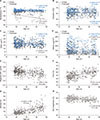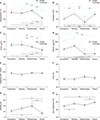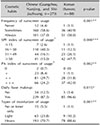Abstract
Background
Objective
Methods
Results
Conclusion
Figures and Tables
Fig. 2
Variation of biophysical parameters according to age. (A~D) Skin surface temperature, hydration level, transepidermal water loss (TEWL), and sebum excretion showed very weak strength of determination coefficient (R-squared, R2). (E, F, and H) Skin elasticity and skin tone decreased and skin pore increased with age, and they showed weak strength of determination coefficient. (G) Wrinkle incresed with age and showed moderate strength of determination coefficient.

Fig. 3
Variation of biophysical parameters according to geographical region. (A, C) Skin surface temperature of the cheek and transepidermal water loss (TEWL) were lowest in Suwon compared to the 3 cities in China. (B) Hydration level was higher in warm cities (Guangzhou and Nanjing) than cold cities (Shijiazhuang and Suwon); in each city group, Nanjing and Suwon, cities which are more humid, demonstrated much higher hydration level. (D) Sebum excretion was higher in warm cities than cold cities. (E, F) Skin elasticity and pore size were not significantly different among the 4 cities. (G, H) The severity of wrinkle was the mildest and skin tone brightest in Suwon compared to the 3 cities in China. **p<0.01, ***p<0.001. Error bar indicates a 95% confidence interval.

Fig. 4
Cosmetic habits according to geographical region. (A~C) Subjects in Suwon had the greatest tendency to use sunscreen everyday and to use sunscreen with high SPF and PA index. (D) A majority of the subjects were shown to wear base makeup daily, with the highest percentage in Suwon. (E) Subjects in Suwon tended to use heavier moisturizers than the 3 cities of China, such as a combined use of toner and cream, or toner, lotion, and cream. T: toner, C: cream, L: lotion. SPF: sun protection factor, PA: protection grade of ultraviolet A.

Fig. 5
Variations of biophysical parameters according to cosmetic habit. (A) Use of sunscreen either sometimes or everyday was associated with low sebum excretion. Use of sunscreen everyday was related to high elasticity. (B) Wearing base makeup daily was linked to high hydration level and low transepidermal water loss (TEWL). (C) Either use of light or heavy moisturizers was associated with high hydration level and low TEWL, with no significant difference between the two types of moisturizers. (D) Use of heavy moisturizers was related to high elasticity. *p<0.05, **p<0.01, †Include use of lotion only, and a combined use of toner and lotion, ‡Include use of cream only, and a combined use of toner and cream, lotion and cream, and toner, lotion, and cream. Error bar indicates a 95% confidence interval.

Table 1
Geographic information of 4 cities and climatic information during the study period*

Values are presented as mean±standard deviation (minimum, maximum). *Data were obtained from following websites: http://latitudelongitude.org, https://www.timeanddate.com. †A mean value of the mean of daily temperature. ‡A mean value of the simple scalar mean of daily wind speed.




 PDF
PDF ePub
ePub Citation
Citation Print
Print






 XML Download
XML Download